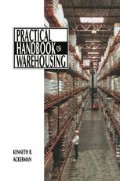Abstract
Warehousing costs have climbed sharply and capital expenditures allotted to warehousing have failed to keep pace with other aspects of business. There are at least three reasons for selecting the warehouse as a target for productivity improvement:1
-
1.
A typical manufacturing concern has 30-to-35 percent of its total under-roof space devoted to the storage of raw materials or finished goods inventory. In most parts of the U.S., increases in construction costs of warehouse space have exceeded the rise in the cost of living. On the average, warehousing costs climbed almost 80 percent between mid-1975 and mid-1979. Higher space costs, along with higher interest costs, have focused attention on the effective use of available space.
-
2.
For manufacturers, warehousing costs (for both raw materials and finished goods) constitute six to eight percent of the sales dollar. Any reduction in warehousing costs quickly flows through to the bottom line. Being labor-intensive, the warehousing function has been especially sensitive to the rapid escalation of labor costs. So worker productivity is a prime concern in attempts to reduce costs.
Access this chapter
Tax calculation will be finalised at checkout
Purchases are for personal use only
Preview
Unable to display preview. Download preview PDF.
References
This chapter is from an article with the same name written by the author and by Bernard J. La Londe of The Ohio State University for Harvard Business Review, March-April 1980.
See Joel C. Wolff, “Work Measurement and Productivity,” Warehousing and Physical Distribution Productivity Report, Vol. 14, No. 6. Marketing Publications Inc., Silver Spring, MD.
Rights and permissions
Copyright information
© 1990 Springer Science+Business Media New York
About this chapter
Cite this chapter
Ackerman, K.B. (1990). Making Warehousing More Efficient. In: Practical Handbook of Warehousing. Springer, Boston, MA. https://doi.org/10.1007/978-1-4757-1194-3_30
Download citation
DOI: https://doi.org/10.1007/978-1-4757-1194-3_30
Publisher Name: Springer, Boston, MA
Print ISBN: 978-1-4757-1196-7
Online ISBN: 978-1-4757-1194-3
eBook Packages: Springer Book Archive

